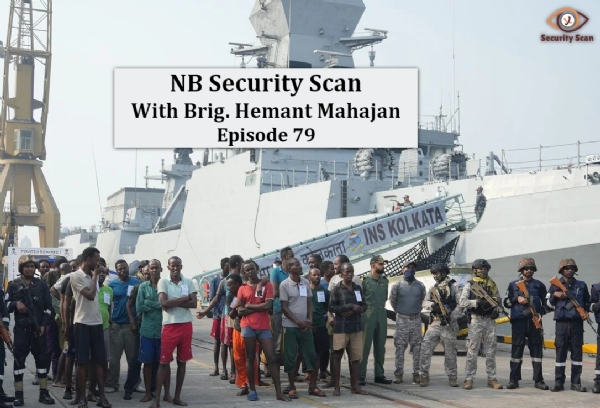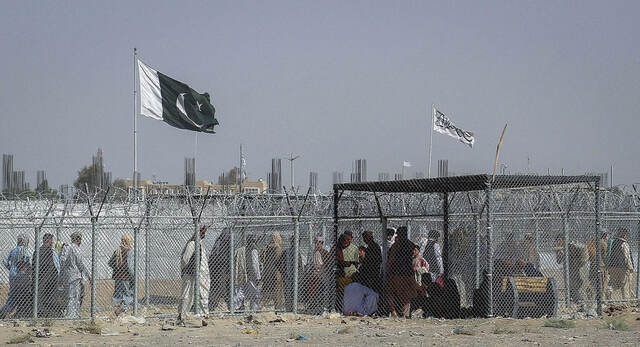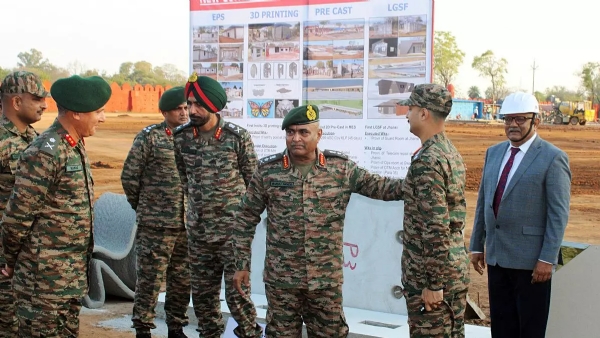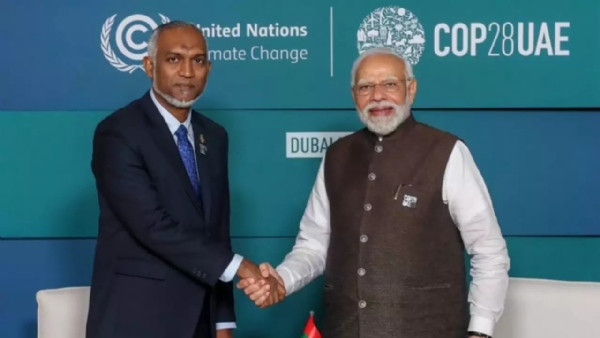#SecurityScan 79: Indian Army's Elite Unit, Indian Navy Anti Piracy Operation & more
According to an annual security report issued by the Centre for Research and Security Studies, Pakistan witnessed 1,524 violence-related fatalities and 1,463 injuries from 789 terror attacks and counter-terror operations in 2023
Total Views |
This article is a summary of important events that have taken place in the last one week affecting India's national security
#COUNTERING CHINESE MULTI DOMAIN, GREYZONE, HIGH BREED WARFARE
Modi visits Bhutan to shore up India's position amid Chinese outreachThimphu keeping New Delhi 'in the loop' on boundary talks with Beijing, experts say

Indian Prime Minister Narendra Modi arrived in Bhutan on Friday, visiting to shore up ties with the Himalayan neighbor as rival China works to increase its influence there.The trip, likely Modi's last foreign journey before he seeks a third term in India's weeks long general election starting April 19, comes about a week after he hosted the new Bhutanese prime minister, Tshering Tobgay, in New Delhi.
India's steadfast response to China's hegemonic manoeuvres In Feb-March
India's steadfast response to China's hegemonic manoeuvres stands as a global exemplar, demonstrating resilience and determination in the face of adversarial tactics. Amidst the ongoing standoff, External Affairs Minister S. Jaishankar reaffirmed India's unwavering stance during a dialogue with Zhou Yongsheng, a political counsellor at the Chinese embassy in New Delhi. Jaishankar underscored the importance of adhering to established agreements and minimizing military presence along the Line of Actual Control (LAC) for mutual benefit. Emphasizing the necessity of a fair resolution respectful of existing agreements, he reiterated India's position that normalizing relations hinges on a return to pre-April 2020 conditions .
Recently, China lodged a diplomatic protest over Prime Minister Narendra Modi's visit to Arunachal Pradesh, reasserting its territorial claims and warning against actions complicating the boundary issue. India swiftly rejected these claims, affirming Arunachal Pradesh's integral status within its territory.
Moreover, significant funds were allocated for the construction of a strategic frontier highway in Arunachal Pradesh, aimed at bolstering connectivity to border areas and fostering socio-economic development.
Simultaneously, India's military capabilities were underscored by the Agni-5 MIRV test, prompting China to monitor the event closely. The Chinese government's mouthpiece, The Global Times, interpreted the test as indicative of India's focus on bolstering deterrence capabilities against China, particularly in light of Prime Minister Modi's visit to Arunachal Pradesh.
Meanwhile, Chinese mobile manufacturers faced scrutiny from Indian authorities regarding compliance with local laws. Despite Chinese media labelling such measures as "trade protectionism," Indian directives aimed to curb illegal practices, exemplified by recent raids on Chinese firms for tax evasion and other violations. This heightened scrutiny reflects India's resolve to enforce regulations, particularly in light of increased tensions post-Galwan.
China's objections to high-level visits to Arunachal Pradesh and its continued interference in India's diplomatic engagements with countries like the United States and Sri Lanka highlight the ongoing competition for regional influence.
India's growing engagement with Taiwan further underscores its willingness to challenge China's sensitivities, evidenced by agreements and collaborative efforts in sectors like semiconductor manufacturing, despite tacit adherence to the one-China policy.
In sum, India's resolute stance against China's hegemonic ambitions remains unwavering, grounded in a commitment to uphold territorial integrity, enforce regulations, and pursue strategic partnerships conducive to its national interests. As India maintains its course, the question remains: Will China recalibrate its approach in the face of India's determined posture?
Xi has already been confronted by his failure to anticipate India's robust military and strategic response, with the standoff driving New Delhi closer to Washington. It also set in motion a major military buildup and modernization drive, as illustrated by a flight test last week to demonstrate that India now can put multiple independently targetable nuclear warheads on a single intercontinental ballistic missile.
Since the standoff began, India has tested several other leading-edge missile systems, including a hypersonic cruise missile, a hybrid missile-torpedo for use against submarines and aircraft carriers, an anti-radiation missile for destroying radar-equipped air defense systems and a new generation, intermediate-range ballistic missile capable of carrying nuclear or conventional warheads.
India has also been importing major weapon systems from the U.S. as well as France and other sources.
The conflict between Pakistan and Afghanistan appears to be reaching a critical juncture
The conflict between Pakistan and Afghanistan appears to be reaching a critical juncture, with the Taliban holding significant influence over the direction it may take. Amidst escalating tensions, characterized by military clashes and accusations of terrorism, the situation resembles a tumultuous breakup between former allies. Here's a breakdown of recent
Recent clashes between Pakistan and the Taliban have intensified, with the Taliban alleging Pakistani air strikes in areas like Barmal and Separa in Afghanistan. According to the Taliban, these strikes resulted in civilian casualties, including women and children.
Pakistan has acknowledged conducting air strikes but maintains that they targeted terrorists within its own territory, not in Afghanistan. Islamabad claims the operation was in response to a terror attack on a military post in Waziristan, attributed to a new group called Jaish-e-Fursan-e-Muhammad, reportedly sheltered by the Taliban.
The Taliban's response has been defiant, accusing Pakistan of incompetence and pledging to defend their territory. Reports suggest retaliatory actions, including clashes near the border targeting Pakistani military installations, signaling a cycle of retaliation.

The conflict's origins trace back to Pakistan's initial support for the Taliban's takeover of Kabul in 2021. However, relations soured as Pakistan sought the Taliban's help in combating the Tehreek-e-Taliban Pakistan (TTP), leading to accusations of Taliban support for the TTP and subsequent terrorist attacks within Pakistan.
Despite efforts through military actions, deportations, and appeals to the international community, Pakistan finds itself increasingly isolated. The weakening civilian government and eroding military influence add to Pakistan's vulnerability.
The recent airstrikes serve as a symbolic display of Pakistan's determination to defend itself, although Islamabad may seek to avoid further escalation by denying involvement in Afghan territory. However, the Taliban's response will shape the trajectory of the conflict, with possibilities of proxy attacks through groups like the TTP.
The conflict underscores the irony of Pakistan's support for the Afghan Taliban against "bad" terrorists while combating their own "good" terrorists, leading to conflict
China condemns Baloch militants' attack on Pakistan's Gwadar port
China on Thursday strongly condemned the Baloch militants' attack on Pakistan's Gwadar Port, a key part of the multi-billion dollar CPEC. The Gwadar Port complex, an integral part of the CPEC project, was the target of the attack, highlighting the strategic importance of the region. Two soldiers of the Pakistani Army were killed and eight Baloch militants were "sent to hell" when security personnel foiled an attempt by heavily armed Baloch insurgents to storm the Gwadar Port Authority complex in the restive Balochistan province, according to the Pakistan military.
The port complex hosts several government and paramilitary offices and the strategically located Gwadar Port remains one of the focal points of the billion-dollar China-Pakistan Economic Corridor (CPEC) Project. Balochistan, bordering Iran and Afghanistan, is home to a long-running violent insurgency.
Baloch insurgent groups have previously carried out several attacks targeting the USD 60 billion CPEC projects. The BLA is opposed to China's investments in Balochistan and accuses Beijing and Islamabad of exploitation of the resource-rich province, a charge rejected by the authorities. Thousands of Chinese personnel are working in Pakistan on several projects being carried out under the aegis of the CPEC. Wednesday's attack comes after a lull in violence and terror activities in the Balochistan province since the February 8 general elections.
According to an annual security report issued by the Centre for Research and Security Studies, Pakistan witnessed 1,524 violence-related fatalities and 1,463 injuries from 789 terror attacks and counter-terror operations in 2023 - marking a record six-year high.
U.S. says border state belongs to New Delhi
Washington opposes encroachments over boundary that Beijing insists is not decidedThe U.S. has stepped coming down firmly on New Delhi's side.A State Department official said that the U.S. "recognizes" the state of Arunachal Pradesh as part of India and rejects attempts by others to assert control over the territory. China claims ownership of the area, which it calls Zangnan, or South Tibet."We strongly oppose any unilateral attempts to advance territorial claims by incursions or encroachments, military or civilian, across the Line of Actual Control.China on Thursday hit back, saying it firmly opposes the U.S. statement. "Delimitation of the China-India boundary has never been completed .
HK security law is final nail in coffin, say critics
Western leaders, the UN and rights groups have joined a chorus of criticism of Hong Kong's new security law, saying it further erodes freedoms. Article 23, as it's known locally, was unanimously passed by the city's pro-Beijing parliament, targeting a range of offences deemed treasonous.Officials say the law is essential for stability but opponents called it a "nail in the city's coffin".China has long pushed for the law and said "smears" by critics would fail.The new law allows for closed-door trials, gives the police rights to detain suspects for up to 16 days without charge and penalties including life sentences, among other things.
This has downed the Hong Kong stock market.
US ‘may be sending strong message’ to China with hypersonic missile test as arms race heats up
US Air Force says its final test of AGM-183A Air-launched Rapid Response Weapon on Sunday ‘intended to further a range of hypersonic programmes’The US and China expected to continue developing hypersonic weapons while also improving their defensive capabilities to neutralise these systems.
US special forces training Taiwanese army on island bases
Taiwan has admitted America is teaching its soldiers how to repel a Chinese invasion on islands as little as three miles from the mainlandThe US has sent special forces to bases on islands controlled by Taiwan that are likely to be on the front line if China were to invade, officials have admitted.Reports of US troops training the Taiwanese armed forces were confirmed by the Taiwanese defence minister, Chiu Kuo-cheng. The reports mentioned the islands of Kinmen and Penghu, the first of which is three miles off the coast of China’s Fujian province, though the minister did not specify which “outlying islands” were involved.“The military may have some blind spots and shortcomings and therefore it is important to communicate with others who are friendly to us,” Chiu said in response to a question posed by local media.
Countering External & Internal Security Challenges
STEAG, the Indian Army's latest elite unit tailored for the warfare of tomorrow
STEAG, short for Signals Technology Evaluation and Adaptation Group, represents a pioneering unit tasked with researching and evaluating cutting-edge communication technologies for future military endeavors. This includes delving into realms such as AI, machine learning, software-defined radios, electronic warfare systems, and the emerging frontier of 6G networks. Embedded within the Indian Army's strategic framework, STEAG stands as a testament to the nation's commitment to technological advancement in defense..
In anticipation of evolving battleground dynamics, the Indian Army has laid the foundation for the Signals Technology Evaluation and Adaptation Group (STEAG), an unprecedented initiative poised to shape the trajectory of military technology.
STEAG's mandate encompasses the comprehensive spectrum of wired and wireless systems, ensuring readiness for the technological demands of tomorrow's warfare landscape.
Pioneering the integration of future-ready technologies, STEAG is tasked with researching and evaluating a diverse array of communication technologies. These span electronic exchanges, mobile communications, software-defined radios, electronic warfare systems, and the impending evolution of 5G and 6G networks. Furthermore, STEAG's purview extends to cutting-edge domains such as quantum technologies, artificial intelligence, machine learning, and quantum computing, all earmarked for strategic military application.

Recognizing the pivotal role of communication in modern warfare, STEAG underscores the importance of technological superiority in gaining a tactical edge over adversaries. As the dynamics of conflict continue to evolve, the ability to seamlessly connect disparate elements and facilitate information sharing will be paramount to success on the battlefield.
Anticipating the imperative of embracing 6G technology, STEAG stands poised to navigate the complexities of future military operations. With its potential to enhance command and control capabilities over unmanned military assets, 6G technology emerges as a force multiplier in shaping the future of warfare.
In the face of evolving threats and operational challenges, the induction of state-of-the-art equipment is indispensable to ensuring seamless communication support for military units and formations. Through initiatives such as STEAG, the Indian Army reaffirms its commitment to embracing technological advancements and enhancing its digital prowess on the battlefield.
What does Saudi Arabia joining the AI race mean for India?Saudi Arabia’s mammoth investment in AI signals a significant escalation in the global AI race.India faces funding challenges
While Saudi Arabia and other Gulf states surge ahead with massive investments, countries like India face the challenge of keeping pace. Despite unveiling its own AI mission, India’s investment pales in comparison, highlighting the need for alternative strategies. India aims to leverage partnerships and talent pool to compete effectively, with potential collaborations with established AI players like NVIDIA on the horizon.
With American firms leading the charge and Gulf states backing their ambitions with substantial funds, the pressure is on for nations like India to accelerate their AI initiatives.
Saudi Arabia’s mammoth investment in AI signals a significant escalation in the global AI race. As technology continues to reshape industries and economies, nations worldwide must adapt swiftly to remain competitive. The future of AI dominance hinges not just on financial prowess but also on fostering innovation, nurturing talent, and fostering strategic partnerships on a global scale.
Anti Piracy Operation Highlights India's Maritime Strength
The recent collaborative effort between the Indian Air Force (IAF) and the Indian Navy to liberate the merchant vessel MV Ruen from pirates in the Arabian Sea stands as a remarkable testament to the efficacy of Indian maritime security measures and inter-service coordination. The operation's success was marked by the precise deployment of two combat boats via the IAF's C-17 heavy-lift aircraft, complemented by the swift action of the Navy's MARCOS commandos. This resulted in the surrender of 35 pirates and the safe release of the vessel and its crew. Furthermore, the proactive stance exhibited by the Navy, reinforced by the presence of vessels like INS Kolkata and INS Subhadra, underscores India's commitment to safeguarding vital global trade routes.
The Navy's approach aligns with the United Nations Convention on the Law of the Sea (UNCLOS), which provides the legal framework for addressing piracy and ensuring safe navigation in international waters. By adhering to UNCLOS standards and engaging in collaborative efforts with global partners, India reaffirms its commitment to upholding maritime law and order, solidifying its position as a frontline responder on the high seas.
India in undersea race to mine world’s battery metal
India is taking another step in its quest to find valuable minerals hidden in the depths of the ocean which could hold the key to a cleaner future. The country, which already has two deep-sea exploration licenses in the Indian Ocean, has applied for two more amid increasing competition between major global powers to secure critical minerals. Countries including China, Russia and India are vying to reach the huge deposits of mineral resources - cobalt, nickel, copper, manganese - that lie thousands of meters below the surface of oceans. These are used to produce renewable energy such as solar and wind power, electric vehicles and battery technology needed to battle against climate change. The UN-affiliated International Seabed Authority (ISA) has issued 31 exploration licenses so far, of which 30 are active. Its member countries are meeting in Jamaica this week to discuss regulations around giving out mining licenses. If the ISA approves India's new applications, its license count will be equal to that of Russia and one less than China.
Recommendations for Accelerating Viksit Bharat
In line with Prime Ministers commitment to incorporating citizen suggestions to fulfill the aspirations of a developed India, I would like to offer some recommendations that could further accelerate the pace of progress:
1. Investment in Education and Skill Development: Prioritize investments in education and skill development programs to equip our youth with the necessary knowledge and expertise to excel in the global economy. Strengthen vocational training initiatives to bridge the gap between formal education and industry requirements.
2. Infrastructure Development: Continue to focus on infrastructure development projects, especially in rural areas, to improve connectivity, access to essential services, and promote economic growth. Embrace sustainable and technology-driven solutions for efficient infrastructure management.
3. Healthcare Access and Affordability: Enhance access to quality healthcare services by expanding the reach of existing schemes and programs. Encourage innovation in healthcare delivery models and promote preventive healthcare measures to reduce the burden of diseases and improve overall well-being.
4. Promotion of Renewable Energy: Accelerate the transition towards renewable energy sources to mitigate climate change and ensure energy security. Incentivize investments in solar, wind, and other clean energy technologies while simultaneously phasing out dependence on fossil fuels.
5. Digital Empowerment: Strengthen digital infrastructure and promote digital literacy initiatives to enable seamless access to government services, financial inclusion, and e-commerce opportunities even in remote areas. Leverage emerging technologies like artificial intelligence and blockchain to drive innovation and efficiency across sectors.
6. Entrepreneurship and Innovation: Foster a conducive ecosystem for entrepreneurship and innovation by providing financial support, mentorship, and regulatory reforms to startups and small businesses. Encourage collaboration between academia, industry, and government to promote research and development initiatives.
7. Environmental Conservation and Sustainability: Implement robust policies and initiatives to conserve natural resources, protect biodiversity, and address environmental challenges such as pollution and deforestation.
8. Empowerment Of Economically Disadvantaged Communities: Prioritize the empowerment and upliftment of marginalized communities, including women, and economically disadvantaged groups, through targeted welfare schemes, skill development programs, and affirmative action measures.

These recommendations, if incorporated into the government's agenda, have the potential to further accelerate the journey towards a Viksit Bharat.
Maldives President Mohamed Muizzu seeks debt relief from India after insisting on withdrawal of military personnel
Muizzu seeks debt relief from India, appreciates aid and emphasizes national security. He expedited projects and achieved results through discussions, amid demands for repatriation of Indian military personnel and strategic importance of Maldives' proximity to India. After his anti-India rhetoric, Maldives President Mohamed Muizzu has struck a reconciliatory tone, saying India will continue to remain his country's "closest ally" and urged New Delhi to provide debt relief to the archipelago nation. The Maldives owed approximately USD 400.9 million to India by the end of last year. Muizzu said India was instrumental in providing aid to the Maldives and has implemented the "greatest number" of projects.
--


